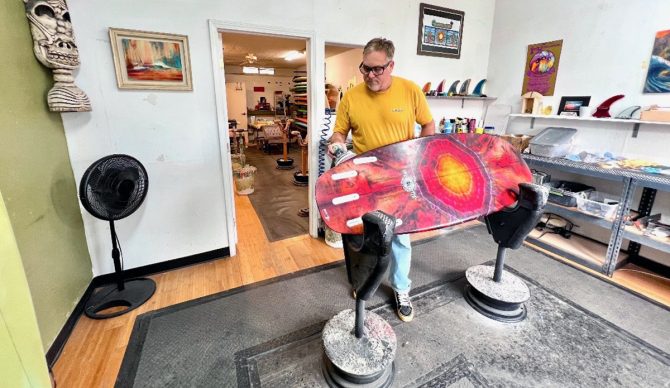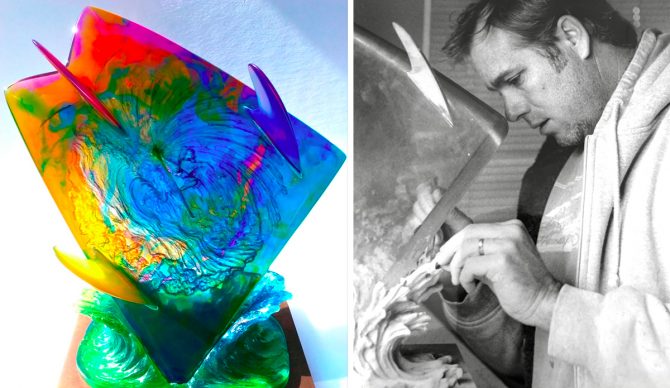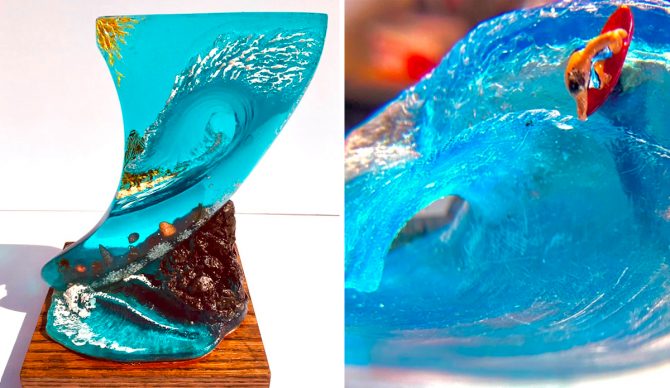
Perry Faanes has repaired thousands of boards over the years. And thrived in San Clemente’s surfboard shaping district. Photo: Rosane Schneider
The line of boards extends to the back of the cement room, tape-covered and soon-to-be repaired. Perry Faanes, wearing his signature thick, black glasses, shuffles around his new shop, gesturing to where things will be. His new storefront, a small, bright-white building reading “Glass Barrels by Perry Faanes” sits just a couple doors down from his old place of work at Terry Senate’s Surf Shop.
Faanes is soft spoken and reminds me of Tom Curren discussing yard work with Jamie Brisick on an episode of Soundings. “A shelf here, a display here,” Perry points. A big, colorful, glass surfing statue which apparently just sold to a man who recently walked in and demanded to buy it. This is one of the reasons Perry enjoys having his own storefront, but not the only one.
When Terry Senate closed his decades-long fixture of a surf shop in the Surf Ghetto of San Clemente, many people mourned the loss of both the shop and the lovable characters inside. Terry and Perry were an unstoppable, and highly acclaimed, duo shaping boards and repairing them for everyone in town, and out-of-town surfers, too, like Zoe Grospiron and Filipe Toledo. Terry and Perry respectively took Best Surfboard Shaper and Best Surfboard Ding Repair at the 16th Annual San Clemente Ole Awards.
After Senate retired in August, then sadly passed away in November, the property owners from his shop approached Perry about setting him up with a shed so he could continue his work after the closure. While Faanes was honored by their generosity, he wanted more than just to continue doing ding repair. “I wanted to step up and have my own showroom right in the front of the ghetto. I wanted to be part of the ghetto. I don’t care how much it costs; I’m still going to be here.”
Faanes presence in San Clemente seems almost eternal, but his story begins in Laguna Beach, where his dad owned the Orange Julius in town. “It was so fun,” he said, “everyone would go there, Corky Carroll, everyone.” Faanes first surfing memory occurred locally, too, next to a local jetty. “I was probably around 10 or 11. I went to Herbie Fletcher and bought a board. It was a spongy paipo board. I was riding on my belly, on my knees, just kind of a kneeboard thing. I just worked my way to my feet, and I was surfing on a paipo.”
Faanes lived in Village San Juan, and “actually miles away, more of an inland area,” Faanes explained. He tells me how he would take the bus to surf every morning. “I was able to get on the bus because my board couldn’t perfectly fit under the scale. Some boards were a little higher, but I would get away with it. But I would take the bus all the way to Doheny. That’s where I kind of grew up surfing.”
By the age of 18, Faanes was fully immersed in the surf industry and began thinking about ways to make a living in surfing. “I worked retail for Infinity,” Faanes said. “I noticed how lucrative ding repair was.” It didn’t seem too far off from working on skis, which Faanes had experience doing. “I liked working with my hands. When I saw how busy ding repair was, I knew I wanted to do it.”

The work, and the result.
“I got to learn about ding repair through Terry Senate,” Perry said. “He showed me how to use all the tools, how you fill the ding and put a patch over it at the same time. It was a one-step method, which some people today don’t even understand and do,” Faanes said. Senate was also gracious enough to give Faanes a key to use his shaping bay for ding repair anytime he wanted.
In between working at the Ritz Carlton, Faanes voluntarily slaved away in the shaping bay, improving his craft. Of course, ding repair soon became a full-time job for Faanes. “I repaired dings for Rip Curl,” Faanes said. “They would send their team riders over to me, including surfers like Mick Fanning.” From all the years working at Terry’s shop and repairing dings for notable pro surfers at the time, Faanes’ skills soon gained traction. “I was quick, I was inexpensive, and word of mouth, it just spread like wildfire.”
The story could easily have ended there. After all, doing ding repair for one’s own boards is no easy task, much less making a career out of doing it for dozens of people week after week. But Faanes told me that the grueling work of ding repair was exactly what led him to his ultimate passion: glass art. Many people see ding repair as an art form, but for Perry, it didn’t quite satisfy his creative side.
With the leftover resin, Faanes began to doodle waves on pieces of tile. “You can capture that wave look, and it’d be dry and nice and colorful. I took that to one of my accounts, Becker’s. I’d show them these cool little waves I made.” The reception was positive, and soon, Becker’s was selling Perry Faanes’ first waves.
From there, Faanes’ work grew exponentially, spurred by self-induced motivation and popularity from his art in the shop. Perry thought he could do better. With more experimentation, he kept churning out waves.
One day, while he was working in his room behind Terry’s surf shop, it occurred to him there may be a way to expedite his art process. His friends urged him to make his own molds and carve and cast the waves instead of making each one by hand. “I looked into silicon molds. I learned how to make a box and put your original in and then pour the silicone. It dries up, you pop your original out, and then you pour the resin back into the mold. You reproduce them.”
“That’s where it was kicking off, ’cause these things were really cool,” Perry laughed. “They’re selling out the retail store, and I’m thinking, ‘all right, I got a cool little gig.’ I wasn’t making much, but I was stoked that people were buying them.”
One day, Faanes had a crazy idea. “How about I put a little door view lens in it and see what it looks like?” He thought. He drilled a little hole through the foam ball, just big enough for someone’s pupil to see through, and immediately knew he had landed on something worth pursuing. “It was like a fisheye,” he explained.
Perry said, straight-faced, “I wasn’t thinking I was Mr. Art Guy. I was just thinking, ‘I got a product’.” In the business of making surfy art pieces people enjoyed, Faanes stumbled upon his biggest idea yet. He attached a magnet to the miniature surfer in the tube, and suddenly, the barrel was interactive. He had made a toy.
“I could pull him in the tube, come out, I could make him do a cut back, whatever. But it just snowballed after that. It went all the way to Mattel Toys,” he laughed. “They made 300,000 of them.”
While the toy deal with Mattel was a “taste of success,” it wasn’t the final stop of the glass barrel journey for Faanes. However, it did provide a needed stepping-stone for what ultimately became one of Faanes’ greatest passions: applying his glass art for trophy making.

A version of the Pipe Masters trophy (left) and a surfers dream.
In the early 2000s, “Rip Curl noticed what I was doing, I saw my art in the Rip Curl store. Next thing you know, they’re knocking on my door. They want me to do grom search trophies.” Bethany Hamilton got one. The Surfer Poll awarded Faanes’ trophies at their banquet ceremony several years in a row.
Despite countless successes, it took a request to create the Pipeline Master’s trophy to finally hit Faanes with a sense of accomplishment. “That’s as good as it gets, you know? It took me three weeks to make that Pipeline Master’s trophy. Drew Brophy was doing art for the contest and flew it over to Hawai’i. Jamie O’Brien won that year, and the runners up were Sonny Garcia, Bruce Irons, and Kalani Rob. It was one of the biggest days ever, the scaffolding was washing away, and there was my trophy,” he smiled.
Now, he’s working on a new piece called the “tail throw.” Like Faanes’ other pieces, it is a psychedelic, surf-inspired sculpture resembling a thruster tail and a wave splashing up behind it. This piece has been used as the U.S. Open trophy and the trophy for the Board Builder’s Hall of Fame.
“Ding repair is a grind, but I get it done,” said Faanes, when pressed on why he remains passionate about creating glass sculptures. “My art can be kind of tiresome, but it’s always fulfilling because all of the pieces are going to a good cause. The kids are stoked on the trophies. I know that they keep these things. My art stays on their desks forever.”

